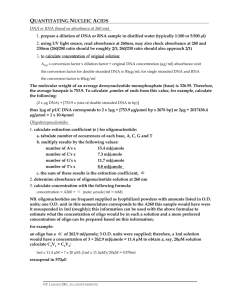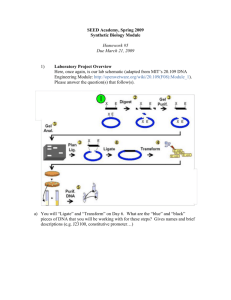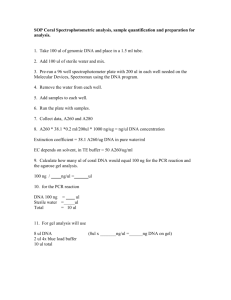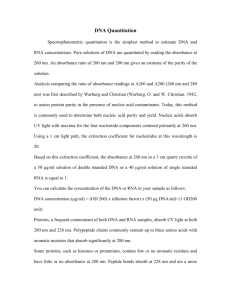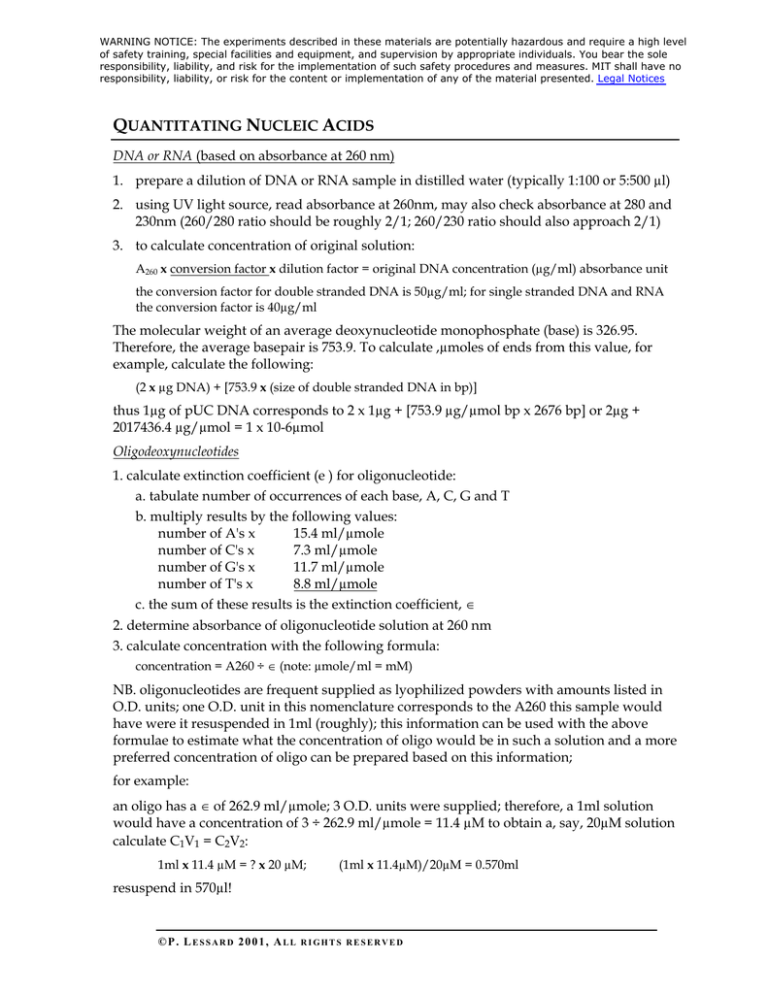
WARNING NOTICE: The experiments described in these materials are potentially hazardous and require a high level
of safety training, special facilities and equipment, and supervision by appropriate individuals. You bear the sole
responsibility, liability, and risk for the implementation of such safety procedures and measures. MIT shall have no
responsibility, liability, or risk for the content or implementation of any of the material presented. Legal Notices
QUANTITATING NUCLEIC ACIDS
DNA or RNA (based on absorbance at 260 nm)
1. prepare a dilution of DNA or RNA sample in distilled water (typically 1:100 or 5:500 µl)
2. using UV light source, read absorbance at 260nm, may also check absorbance at 280 and
230nm (260/280 ratio should be roughly 2/1; 260/230 ratio should also approach 2/1)
3. to calculate concentration of original solution:
A260 x conversion factor x dilution factor = original DNA concentration (µg/ml) absorbance unit
the conversion factor for double stranded DNA is 50µg/ml; for single stranded DNA and RNA
the conversion factor is 40µg/ml
The molecular weight of an average deoxynucleotide monophosphate (base) is 326.95.
Therefore, the average basepair is 753.9. To calculate ,µmoles of ends from this value, for
example, calculate the following:
(2 x µg DNA) + [753.9 x (size of double stranded DNA in bp)]
thus 1µg of pUC DNA corresponds to 2 x 1µg + [753.9 µg/µmol bp x 2676 bp] or 2µg +
2017436.4 µg/µmol = 1 x 10-6µmol
Oligodeoxynucleotides
1. calculate extinction coefficient (e ) for oligonucleotide:
a. tabulate number of occurrences of each base, A, C, G and T
b. multiply results by the following values:
number of A's x
15.4 ml/µmole
number of C's x
7.3 ml/µmole
number of G's x
11.7 ml/µmole
number of T's x
8.8 ml/µmole
c. the sum of these results is the extinction coefficient, ∈
2. determine absorbance of oligonucleotide solution at 260 nm
3. calculate concentration with the following formula:
concentration = A260 ÷ ∈ (note: µmole/ml = mM)
NB. oligonucleotides are frequent supplied as lyophilized powders with amounts listed in
O.D. units; one O.D. unit in this nomenclature corresponds to the A260 this sample would
have were it resuspended in 1ml (roughly); this information can be used with the above
formulae to estimate what the concentration of oligo would be in such a solution and a more
preferred concentration of oligo can be prepared based on this information;
for example:
an oligo has a ∈ of 262.9 ml/µmole; 3 O.D. units were supplied; therefore, a 1ml solution
would have a concentration of 3 ÷ 262.9 ml/µmole = 11.4 µM to obtain a, say, 20µM solution
calculate C1V1 = C2V2:
1ml x 11.4 µM = ? x 20 µM;
(1ml x 11.4µM)/20µM = 0.570ml
resuspend in 570µl!
©P. LESSARD 2001, ALL
RIGHTS RESERVED

